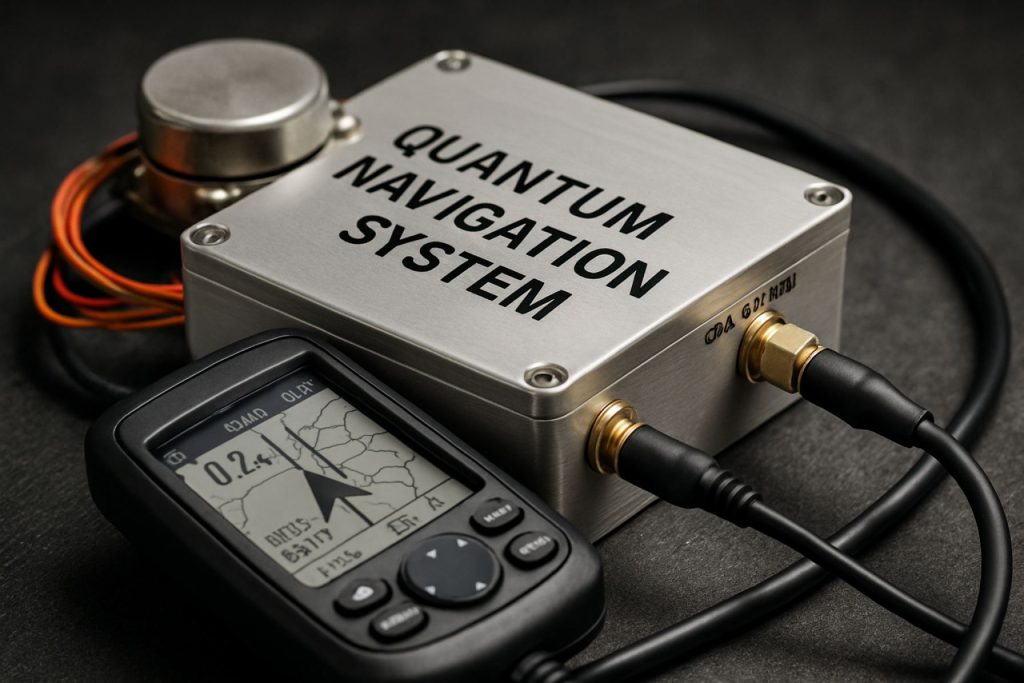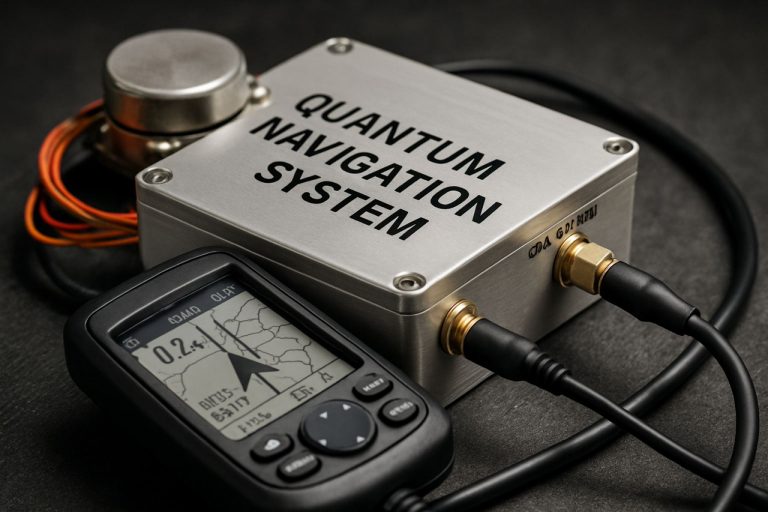
Quantum-Enhanced Navigation Systems in 2025: Transforming Precision, Security, and Global Positioning for the Next Era. Explore How Quantum Tech is Redefining Navigation Across Aerospace, Defense, and Autonomous Vehicles.
- Executive Summary: Quantum Navigation’s 2025 Landscape
- Market Size, Growth Rate, and Forecasts to 2030
- Key Technology Innovations: Quantum Sensors, Clocks, and Gravimeters
- Competitive Landscape: Leading Companies and Industry Alliances
- Applications Across Sectors: Aerospace, Defense, Maritime, and Automotive
- Regulatory Environment and Industry Standards
- Challenges: Scalability, Cost, and Integration Barriers
- Case Studies: Real-World Deployments and Pilot Programs
- Investment Trends and Funding Activity
- Future Outlook: Quantum Navigation’s Role in the Next 5 Years
- Sources & References
Executive Summary: Quantum Navigation’s 2025 Landscape
Quantum-enhanced navigation systems are poised to redefine positioning, navigation, and timing (PNT) capabilities in 2025, addressing vulnerabilities in traditional satellite-based systems such as GPS. These next-generation solutions leverage quantum technologies—particularly quantum sensors and atomic interferometry—to deliver highly accurate, resilient navigation even in GPS-denied environments. The global push for robust alternatives is driven by both commercial and defense sectors, with significant investments and pilot deployments underway.
In 2025, several leading organizations are advancing quantum navigation from laboratory prototypes to field-ready systems. The United Kingdom’s National Quantum Technologies Programme, in collaboration with industry partners, has accelerated the development of quantum accelerometers and gyroscopes for navigation, with field trials demonstrating sub-meter accuracy over extended periods without satellite input. Similarly, BAE Systems is actively developing quantum inertial navigation units, targeting integration into military platforms and commercial vessels. Their efforts are complemented by QinetiQ, which is testing quantum gravimeters and accelerometers for both defense and civil applications.
In the United States, Northrop Grumman and Lockheed Martin are investing in quantum navigation research, with prototypes undergoing evaluation for aircraft and autonomous systems. These companies are collaborating with national laboratories and academic institutions to accelerate the transition from research to deployable products. Meanwhile, Thales Group in Europe is advancing quantum-based navigation for aerospace and rail, with pilot projects demonstrating improved reliability in challenging environments.
The commercial sector is also witnessing momentum. Startups and spinouts, such as those supported by the UK’s Quantum Communications Hub, are working on miniaturized quantum sensors suitable for integration into autonomous vehicles and maritime navigation systems. These efforts are supported by government funding and public-private partnerships, reflecting the strategic importance of quantum navigation for critical infrastructure and national security.
Looking ahead, the outlook for quantum-enhanced navigation systems in the next few years is marked by continued field trials, early commercial deployments, and growing cross-sector collaboration. As quantum sensor technology matures and manufacturing scales, industry experts anticipate broader adoption in defense, aviation, shipping, and autonomous mobility. By the late 2020s, quantum navigation is expected to become a cornerstone of resilient PNT architectures, offering a robust complement—and, in some scenarios, an alternative—to satellite-based systems.
Market Size, Growth Rate, and Forecasts to 2030
The market for quantum-enhanced navigation systems is poised for significant growth as industries seek alternatives to traditional satellite-based navigation, particularly in environments where GPS signals are unreliable or unavailable. As of 2025, the sector is transitioning from research and prototyping to early-stage commercialization, driven by advances in quantum sensors—especially quantum accelerometers and gyroscopes—that promise unprecedented precision and resilience.
Key players in this emerging market include Moog Inc., which has invested in quantum inertial navigation technologies, and Northrop Grumman Corporation, known for its work on quantum sensors for defense and aerospace applications. In Europe, BAE Systems plc and Thales Group are actively developing quantum navigation solutions, with several demonstration projects underway in collaboration with government agencies and research institutions.
The current market size for quantum-enhanced navigation systems is estimated to be in the low hundreds of millions of USD, with the majority of revenue stemming from government contracts, defense, and aerospace sectors. For example, the UK government has invested over £100 million in quantum technology programs, with a significant portion allocated to navigation and timing solutions (UK Government). The U.S. Department of Defense and allied agencies are also funding quantum navigation R&D, reflecting the strategic importance of GPS-independent navigation.
Growth rates are expected to accelerate through the latter half of the decade. Industry forecasts suggest a compound annual growth rate (CAGR) of 25–35% through 2030, as quantum navigation systems move from pilot deployments to broader adoption in commercial aviation, maritime, autonomous vehicles, and critical infrastructure. By 2030, the global market is projected to reach several billion USD, with defense and aerospace remaining dominant segments, but with increasing uptake in commercial and industrial applications as costs decrease and technology matures.
- 2025: Early commercial deployments, primarily in defense and aerospace.
- 2026–2028: Expansion into commercial aviation, maritime, and autonomous vehicles as pilot projects prove viability.
- 2029–2030: Broader adoption across critical infrastructure, logistics, and high-value industrial sectors.
The outlook for quantum-enhanced navigation systems is robust, with ongoing investment from both public and private sectors. As technical barriers are overcome and supply chains mature, the market is expected to experience rapid growth, positioning quantum navigation as a cornerstone technology for resilient, high-precision positioning in the coming years.
Key Technology Innovations: Quantum Sensors, Clocks, and Gravimeters
Quantum-enhanced navigation systems are rapidly advancing, driven by breakthroughs in quantum sensors, atomic clocks, and gravimeters. These technologies promise to revolutionize navigation by providing highly accurate, resilient alternatives to satellite-based systems like GPS, which are vulnerable to jamming and spoofing. As of 2025, several key innovations are shaping the field and setting the stage for widespread adoption in the coming years.
Quantum sensors, particularly those based on cold atom interferometry, are at the forefront of this transformation. These sensors exploit the quantum properties of atoms to measure acceleration and rotation with unprecedented precision. For example, BAE Systems has demonstrated a quantum accelerometer capable of providing navigation data independent of external signals, a critical capability for submarines and aircraft operating in GPS-denied environments. Similarly, Northrop Grumman is actively developing quantum inertial measurement units (IMUs) that integrate quantum accelerometers and gyroscopes, aiming to enhance the accuracy and reliability of navigation systems for defense and aerospace applications.
Atomic clocks are another cornerstone of quantum navigation. These devices use the oscillations of atoms, such as cesium or rubidium, to keep time with extraordinary stability. The latest chip-scale atomic clocks (CSACs) are compact enough for integration into portable navigation devices, offering timing accuracy that can maintain precise positioning even during extended GPS outages. Microchip Technology Inc. is a leading supplier of CSACs, supporting both commercial and military navigation systems with robust, miniaturized timing solutions.
Quantum gravimeters, which measure local variations in gravity, are emerging as a complementary technology for navigation. By mapping gravitational anomalies, these devices can help determine position with high accuracy, especially in environments where traditional navigation aids are unavailable. Muquans, a subsidiary of iXblue, has commercialized quantum gravimeters that are being evaluated for geophysical surveys and navigation in challenging terrains.
Looking ahead, the integration of quantum sensors, clocks, and gravimeters into navigation systems is expected to accelerate. Governments and industry leaders are investing heavily in field trials and prototype deployments, with operational systems anticipated within the next few years. As quantum technologies mature, they are poised to deliver resilient, high-precision navigation capabilities for defense, aerospace, maritime, and autonomous vehicle sectors, fundamentally reshaping the landscape of positioning and timing.
Competitive Landscape: Leading Companies and Industry Alliances
The competitive landscape for quantum-enhanced navigation systems in 2025 is characterized by a dynamic interplay between established aerospace and defense giants, innovative quantum technology startups, and strategic industry alliances. As the demand for resilient, GPS-independent navigation solutions intensifies—driven by both military and commercial imperatives—key players are accelerating research, prototyping, and early-stage deployments of quantum sensors and inertial navigation units.
Among the most prominent companies, BAE Systems stands out for its sustained investment in quantum navigation research. The company has publicly demonstrated quantum accelerometer prototypes and is collaborating with academic partners to transition these technologies toward operational readiness. Similarly, Northrop Grumman is advancing quantum inertial measurement units (IMUs) for defense applications, leveraging its expertise in avionics and sensor integration.
In Europe, Airbus is actively exploring quantum-enhanced navigation for both aerospace and space missions, with a focus on integrating quantum sensors into next-generation aircraft and satellites. The company is also involved in several European Union-funded consortia aimed at accelerating the commercialization of quantum navigation technologies.
On the startup front, UK-based M Squared and Germany’s Menlo Systems are notable for their development of compact quantum sensors and atomic clocks, which are critical components for quantum navigation. These firms are increasingly partnering with larger aerospace and defense contractors to bring their innovations to market.
Industry alliances and government-backed initiatives are playing a pivotal role in shaping the competitive landscape. The U.S. National Quantum Initiative and the European Union’s Quantum Flagship program are fostering collaboration between academia, startups, and established industry players, with dedicated funding streams for navigation-related quantum technologies. In the UK, the UK Research and Innovation (UKRI) agency is supporting the National Quantum Technologies Programme, which includes a focus on quantum navigation and timing.
Looking ahead, the next few years are expected to see intensified competition as prototype quantum navigation systems transition to field trials and limited operational deployments. Strategic partnerships—such as those between quantum sensor startups and major defense integrators—are likely to accelerate commercialization. The sector’s trajectory will be shaped by advances in miniaturization, robustness, and integration of quantum sensors, as well as by evolving regulatory and security requirements for navigation in contested or denied environments.
Applications Across Sectors: Aerospace, Defense, Maritime, and Automotive
Quantum-enhanced navigation systems are rapidly transitioning from laboratory prototypes to real-world applications across aerospace, defense, maritime, and automotive sectors. These systems leverage quantum technologies—such as quantum sensors, atomic clocks, and quantum gyroscopes—to deliver unprecedented accuracy and resilience, particularly in environments where traditional Global Navigation Satellite Systems (GNSS) are unreliable or denied.
In aerospace, quantum navigation is being explored to address the vulnerabilities of satellite-based navigation. Leading aerospace manufacturers and agencies are investing in quantum inertial navigation units (QINU) that utilize cold atom interferometry to maintain precise positioning during GNSS outages. For example, Airbus has publicly discussed its research into quantum sensors for aircraft navigation, aiming to enhance both civil and military aviation safety and autonomy. Similarly, Boeing is known to be investigating quantum technologies for next-generation avionics, with a focus on robust, jam-resistant navigation solutions.
The defense sector is a primary driver of quantum navigation innovation, motivated by the need for secure and resilient positioning in contested environments. Organizations such as Lockheed Martin and Northrop Grumman are actively developing quantum-based inertial measurement units (IMUs) and atomic clocks for military platforms, including aircraft, submarines, and autonomous vehicles. These systems promise to provide accurate navigation even in GPS-denied scenarios, a critical capability for modern defense operations. The U.S. Department of Defense has also signaled significant investment in quantum navigation as part of its broader quantum technology initiatives.
Maritime applications are emerging as well, with quantum navigation systems being tested for use in commercial shipping and naval vessels. Companies like Thales Group are developing quantum accelerometers and gyroscopes to improve navigation accuracy in open seas, where GNSS signals can be unreliable due to atmospheric or intentional interference. These advancements are expected to enhance both safety and operational efficiency for maritime operators.
In the automotive sector, the integration of quantum sensors is in its early stages but progressing rapidly. Major automotive suppliers, including Bosch, are researching quantum-enhanced IMUs for autonomous vehicles, aiming to provide precise localization in urban canyons or tunnels where satellite signals are obstructed. The next few years are likely to see pilot deployments in advanced driver-assistance systems (ADAS) and fully autonomous vehicles, as quantum navigation matures and miniaturization challenges are addressed.
Looking ahead to 2025 and beyond, the outlook for quantum-enhanced navigation systems is marked by increasing cross-sector collaboration, government funding, and early-stage commercial deployments. As quantum technologies continue to advance, their integration into critical navigation infrastructure is expected to accelerate, driving transformative improvements in accuracy, security, and operational resilience across aerospace, defense, maritime, and automotive domains.
Regulatory Environment and Industry Standards
The regulatory environment for quantum-enhanced navigation systems is rapidly evolving as these technologies transition from laboratory prototypes to real-world applications. In 2025, the primary focus of regulators and industry bodies is to ensure the safe, secure, and interoperable deployment of quantum sensors—such as quantum accelerometers and gyroscopes—within critical navigation infrastructure, including aviation, maritime, and autonomous vehicles.
Currently, there is no single global standard governing quantum navigation systems. However, several national and international organizations are actively developing frameworks and guidelines. In the United States, the National Institute of Standards and Technology (NIST) is engaged in research and stakeholder consultations to establish measurement standards and performance benchmarks for quantum sensors. Similarly, the European Telecommunications Standards Institute (ETSI) has launched industry working groups to address quantum technologies, including navigation, with a focus on interoperability and cybersecurity.
Industry consortia are also playing a significant role. The Institute of Physics in the UK, in collaboration with the UK Government, is supporting the Quantum Technologies Innovation Centre, which is working to define best practices and certification pathways for quantum navigation devices. These efforts are complemented by the International Organization for Standardization (ISO), which has initiated preliminary discussions on standardizing quantum sensor performance metrics, though formal standards are not expected before 2027.
On the industry side, leading manufacturers such as BAE Systems and Northrop Grumman are actively participating in regulatory forums and pilot programs to demonstrate compliance with emerging guidelines. These companies are also collaborating with government agencies to ensure that quantum navigation systems meet stringent requirements for resilience against spoofing and jamming, which are critical for defense and aerospace applications.
Looking ahead, the next few years will likely see the introduction of provisional certification schemes and voluntary compliance programs, as regulators seek to balance innovation with safety and security. The anticipated growth in commercial deployment—particularly in sectors vulnerable to GPS denial—will drive further harmonization of standards across jurisdictions. As quantum-enhanced navigation matures, regulatory clarity and robust industry standards will be essential to unlocking its full potential in global navigation and positioning markets.
Challenges: Scalability, Cost, and Integration Barriers
Quantum-enhanced navigation systems, leveraging quantum sensors such as atom interferometers and quantum gyroscopes, promise unprecedented accuracy and resilience against signal denial. However, as of 2025, the sector faces significant challenges in scalability, cost, and integration that must be addressed before widespread adoption is feasible.
A primary barrier is the scalability of quantum navigation hardware. Current prototypes, such as those developed by BAE Systems and Northrop Grumman, often require complex vacuum systems, cryogenic cooling, and vibration isolation, resulting in bulky and delicate setups. While laboratory demonstrations have shown high-precision performance, miniaturizing these systems for deployment in aircraft, ships, or autonomous vehicles remains a formidable engineering challenge. Efforts are underway to develop more compact, robust devices, with Moog Inc. and Honeywell also investing in quantum inertial sensor research, but commercial-grade, field-deployable solutions are not expected before the late 2020s.
Cost is another significant hurdle. Quantum navigation prototypes currently command high price tags due to the use of specialized materials, precision manufacturing, and the need for highly skilled personnel for operation and maintenance. For example, the quantum accelerometers and gyroscopes under development by BAE Systems are still in the experimental phase, with costs far exceeding those of conventional inertial navigation systems. Without breakthroughs in manufacturing processes and component standardization, the economic case for replacing or supplementing existing navigation technologies remains weak for most commercial applications.
Integration with existing navigation infrastructure presents further complications. Quantum sensors generate data in formats and at rates that differ from traditional systems, necessitating new interfaces and data fusion algorithms. Additionally, ensuring compatibility with legacy avionics, maritime, and automotive platforms requires extensive testing and certification. Organizations such as Northrop Grumman and Honeywell are collaborating with government agencies and standards bodies to develop interoperability protocols, but regulatory frameworks are still evolving.
Looking ahead, the next few years are likely to see incremental progress, with pilot deployments in defense and high-value commercial sectors. However, overcoming the intertwined challenges of scalability, cost, and integration will be essential for quantum-enhanced navigation systems to achieve mainstream adoption beyond specialized or mission-critical environments.
Case Studies: Real-World Deployments and Pilot Programs
Quantum-enhanced navigation systems are transitioning from laboratory prototypes to real-world deployments, with several high-profile pilot programs and operational trials underway as of 2025. These systems, leveraging quantum sensors such as quantum accelerometers and gyroscopes, promise navigation capabilities independent of satellite signals—an increasingly critical feature in GPS-denied or spoofed environments.
One of the most notable case studies is the collaboration between BAE Systems and the University of Birmingham, which has resulted in the development and field testing of a quantum inertial navigation system (Q-INS). In 2023 and 2024, BAE Systems publicly demonstrated a quantum navigation prototype aboard a Royal Navy vessel, successfully maintaining accurate positioning during periods of GPS signal loss. The system utilizes ultra-cold atoms to measure acceleration and rotation with unprecedented precision, and further sea trials are scheduled throughout 2025 to validate performance in diverse maritime conditions.
In the aviation sector, Airbus has initiated pilot programs integrating quantum sensors into commercial aircraft avionics. In partnership with quantum technology firms and European research institutes, Airbus is testing quantum-enhanced inertial measurement units (IMUs) on select test flights. These trials, ongoing since late 2024, aim to assess the reliability and resilience of quantum navigation under real-world flight dynamics, with initial results indicating significant improvements in drift reduction compared to conventional IMUs.
On the land mobility front, QinetiQ has been working with the UK Ministry of Defence to deploy quantum navigation systems in military vehicles. Field exercises conducted in 2024 and early 2025 have demonstrated the ability of quantum sensors to provide accurate positioning in GPS-denied environments such as urban canyons and underground facilities. QinetiQ’s quantum navigation platform is designed for modular integration, allowing rapid deployment across various vehicle types.
Looking ahead, these pilot programs are expected to expand in scale and scope. The UK government’s National Quantum Technologies Programme, which supports many of these initiatives, has outlined plans for broader operational trials in both civilian and defense sectors through 2026. Meanwhile, industry leaders such as Northrop Grumman in the United States are investing in parallel quantum navigation research, with anticipated demonstrations in aerospace and defense applications within the next few years.
Collectively, these case studies underscore the accelerating pace of quantum navigation system deployment, with 2025 marking a pivotal year for real-world validation and the first steps toward commercial and military adoption.
Investment Trends and Funding Activity
Investment in quantum-enhanced navigation systems has accelerated markedly in 2025, reflecting both the maturation of quantum sensor technologies and growing demand for resilient, GPS-independent navigation solutions. This surge is driven by strategic priorities in defense, aerospace, and critical infrastructure, where quantum-based inertial navigation systems (QINS) promise unprecedented accuracy and robustness against jamming or spoofing.
Key players in this sector include BAE Systems, which has publicly demonstrated quantum navigation prototypes and continues to receive significant government and private funding for further development. In 2024, BAE Systems announced successful trials of a quantum accelerometer for navigation, and in 2025, the company has expanded its partnerships with UK defense agencies to accelerate commercialization. Similarly, Northrop Grumman is investing in quantum inertial measurement units (IMUs), leveraging its expertise in advanced navigation for aerospace and military applications.
Startups and university spinouts are also attracting substantial venture capital. Muquans, a French company specializing in quantum sensors, has secured new rounds of funding in 2025 to scale production of its quantum gravimeters and accelerometers, targeting both civil and defense markets. In the US, ColdQuanta (now operating as Infleqtion) has raised additional capital to advance its quantum sensing platform, with a focus on navigation and timing solutions for aerospace and autonomous vehicles.
Government funding remains a cornerstone of the sector’s growth. The UK’s National Quantum Technologies Programme, with ongoing support through 2025, has allocated hundreds of millions of pounds to quantum navigation research, supporting both academic and industrial consortia. In the US, the Department of Defense and DARPA continue to issue contracts and grants for quantum navigation R&D, with a focus on field-deployable prototypes.
Looking ahead, analysts expect investment activity to intensify as quantum navigation systems approach commercial readiness. Strategic acquisitions are likely, as established aerospace and defense firms seek to integrate quantum capabilities. The next few years will see increased collaboration between quantum hardware startups, system integrators, and end-users, with pilot deployments anticipated in both military and commercial aviation by 2027. The sector’s funding landscape is thus characterized by a blend of public and private capital, with a clear trajectory toward operational deployment and market expansion.
Future Outlook: Quantum Navigation’s Role in the Next 5 Years
Quantum-enhanced navigation systems are poised to transition from experimental prototypes to early operational deployments over the next five years, driven by advances in quantum sensing and the growing demand for resilient, GPS-independent navigation. As of 2025, several leading organizations are accelerating the development and field testing of quantum inertial sensors, gravimeters, and atomic clocks, which promise to deliver unprecedented accuracy and robustness in navigation, especially in GPS-denied environments.
A key milestone in 2024 was the demonstration of a portable quantum accelerometer by BAE Systems, in collaboration with academic partners, which showcased the potential for quantum sensors to maintain precise positioning without satellite signals. Building on this, BAE Systems is expected to continue refining its quantum navigation prototypes, targeting integration into military and commercial platforms by 2027. Similarly, Northrop Grumman and Lockheed Martin are investing in quantum sensor research, with a focus on enhancing the resilience of navigation systems for aerospace and defense applications.
In Europe, Airbus is advancing quantum-based navigation through its involvement in the UK Quantum Technology Hub Sensors and Timing initiative, aiming to deliver deployable quantum inertial navigation units for civil aviation and maritime sectors by the late 2020s. Meanwhile, Honeywell is leveraging its expertise in precision measurement and atomic clocks to develop quantum-enhanced inertial measurement units (IMUs) for both commercial and defense customers, with pilot programs anticipated within the next three years.
The outlook for quantum navigation is further bolstered by government-backed initiatives in the US, UK, and EU, which are providing significant funding for quantum technology commercialization. The US Department of Defense and the UK Ministry of Defence have both identified quantum navigation as a strategic priority, supporting testbeds and early adoption in military vehicles and submarines.
By 2030, quantum-enhanced navigation systems are expected to move beyond niche applications, with early adopters in aviation, shipping, and autonomous vehicles benefiting from improved accuracy, security, and independence from vulnerable satellite infrastructure. However, challenges remain in miniaturization, cost reduction, and system integration. The next five years will be critical for demonstrating operational reliability and scaling production, setting the stage for broader industry adoption in the decade ahead.
Sources & References
- Northrop Grumman
- Lockheed Martin
- Thales Group
- Quantum Communications Hub
- Moog Inc.
- UK Government
- Airbus
- Menlo Systems
- Boeing
- Bosch
- National Institute of Standards and Technology
- International Organization for Standardization
- Honeywell



